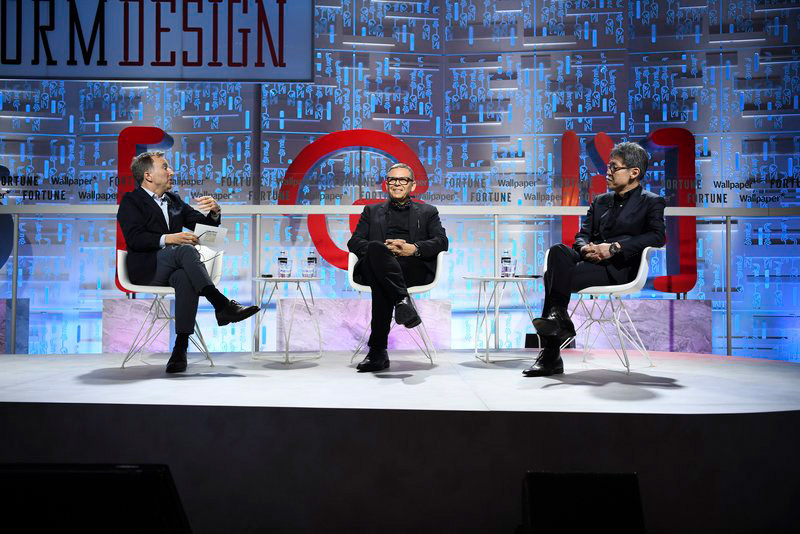设计专家畅谈未来汽车设计

|
两周前,《财富》杂志和《墙纸》(Wallpaper*)杂志在新加坡共同举办的头脑风暴设计大会上,两位全球顶尖的汽车设计师说,汽车世界正在发生重大变化。 前田几雄和彼得·希瑞尔走上行业巅峰的历史不尽相同。来自于东京的前田是马自达传奇设计师前田又三郎的儿子,他追随父亲的脚步,1982年加入了马自达,2000年升任设计总监。与此同时,来自于法兰克福的希瑞尔先后担任奥迪、大众、起亚的设计总监,之后成为现代汽车的总裁及设计管理负责人。 他们对汽车技术的进步抱有相似的愿望。但他们也思考过汽车行业或许前景黯淡的想法——有人认为共享经济导致个人交通出行行业衰落,可能会让汽车变成“仅仅是为大众提供代步工具的商品。”前田说,“不过在马自达,我们相信仍然会有人将汽车视作朋友、伙伴和家人。汽车是特别的,不可替代。” 希瑞尔指出,汽车一直是自由的象征,他回忆了17岁那年一拿到驾照就开车上路的情景,何其快乐。现在,算法和人工智能似乎正在妨碍我们获得这种自由。“有这么多程序试着了解我们,替我们做决定。”他说,“我们的想象力在流失。” “过去,如果你想从一个地方去另外一个地方,你要看地图。”他接着说,“你像鸽子一样,感觉自己在航行。如今你只需要打开车上的导航系统,一边开车一边看着显示器。” 他补充说:“我认为人工智能应该扮演智能辅助的角色。我们需要重新定义自由在这个新时代的意义,而不仅仅是被机器娱乐,被机器统治。它们无法取代人类的创造力[……]包豪斯经常引用希腊哲学家普罗塔哥拉的话,他说:‘人是衡量一切事物的标准。’作为设计师,我们必须牢记这一点。” 前田说:“我害怕的是,我们一旦把注意力放在创新和技术上,就没有时间去思考美,其实必须兼而有之。”在马自达,前田的口头禅是“把汽车作为艺术”,用美学的吸引力加深车主与汽车之间的关系。他举了马自达RX Vision Coupe车型的例子。日本人欣赏四季光线变幻的美,他们称之为Utsuroi(推移变化)。Vision Coupe车型即受此启发,利用汽车移动时对光线的反射,创造了一种流动的形态,“让汽车活了起来。”他说,“一辆真正漂亮的汽车可以改变黯淡的城市空间,让城市焕发生机。” 希瑞尔认为,从更加务实的层面考虑,汽车的美感以及它所包含的情感元素对品牌建设也至关重要。“如果一个品牌想活下来,就要有灵魂,要有故事,要代表某种东西。”他说,“所以我不认为,汽车最后会变成没有感情色彩的盒子,而我们的设计将继续以满足人类真实体验为中心。”(财富中文网) 译者:Agatha |
There are big changes afoot in the automotive world, according to two leading car designers who spoke two weeks ago at Brainstorm Design, a conference in Singapore co-organized by Fortune and Wallpaper* magazines. Ikuo Maeda and Peter Schreyer took different paths to the top of their industry. Tokyo-based Maeda is the son of Matasaburo Maeda, a legendary designer at Mazda, and followed his father’s footsteps to the automaker in 1982, rising to his current role as head of design in 2000. Meanwhile, Frankfurt-based Schreyer was design chief for Audi, Volkswagen, and then Kia, before becoming president and head of design management at Hyundai. They share similar hopes for advances in car technology. But they have given thought too to bleaker prophecies—some have suggested that the sharing economy, and thus the decline of individual transport, may transform the car into “a mere commodity, mobility tool for the masses,” said Maeda. “Though at Mazda we believe that there will still be people who see their car as their friend, partner, and a member of their family. That a car is something special and irreplaceable.” Schreyer pointed out that cars have always been symbols of freedom, recalling how he happily drove off at the age of 17 as soon as he earned his license. Now algorithms and artificial intelligence seem to be getting in the way of this freedom. “We have all these programs that learn about us and can make decisions for us,” he said. “So we are losing the culture of fantasy.” “In the olden days, when you wanted to go from one place to another, you looked on the map,” he continued. “You had a sense for navigation like a pigeon. Nowadays you just put on the navigation system in your car and you drive, looking at the screen.” He added: “I think artificial intelligence should be thought of as intelligent assistance. We need to redefine what freedom means in this new era, and not just be entertained and ruled by machines. They cannot replace human creativity […] The Bauhaus would often quote the Greek philosopher Protagoras, who said, ‘man is the measure of all things.’ We as designers must keep this in mind.” “What I’m afraid of,” followed Maeda, “is that once we put our attention to innovation and technology, we don’t have any time to think about beauty. We have to think both ways.” At Mazda, Maeda’s mantra has been “car as art”—using aesthetic allure to reinforce the connection between rider and car. He cited the RX Vision Coupe as an example. In Japan, people have an appreciation for the way light changes throughout the four seasons, which they call Utsuroi. This inspired a flowing form for the Vision Coupe that leverages reflected light while the car is in motion, “to make it come alive,” he said. “A truly beautiful car can transform bleak city spaces and color the city anew.” On a more pragmatic level, Scheyer suggested that the beauty of a car, and thus its emotional charge is essential to brand building too. “If a brand wants to survive, it needs a soul. It needs to tell a story, and it needs to stand for something,” he said. “So I don’t think we’ll ever end up with cars that are neutral boxes. We will continue to design for the human experience.” |













